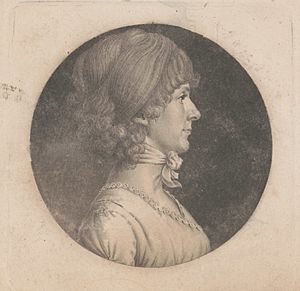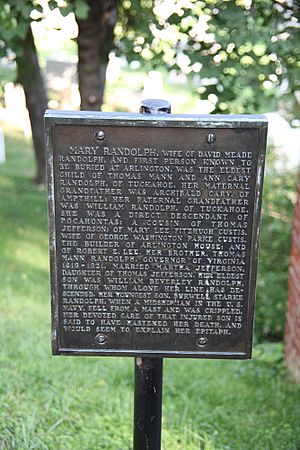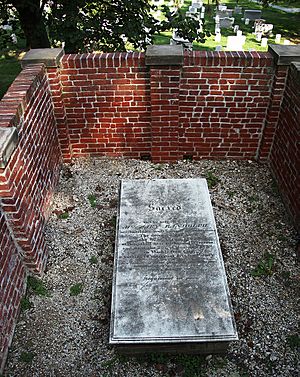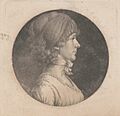Mary Randolph facts for kids
Quick facts for kids
Mary Randolph
|
|
|---|---|

1807 engraving of Mary Randolph
|
|
| Born | August 9, 1762 |
| Died | January 23, 1828 (aged 65) Washington, D.C., U.S.
|
| Resting place | Arlington National Cemetery |
| Occupation | Writer |
| Spouse(s) |
David Meade Randolph
(m. 1780) |
| Children | 4 |
| Parent(s) | Thomas Mann Randolph Sr. Ann Cary Randolph |
| Relatives |
|
Mary Randolph (born August 9, 1762 – died January 23, 1828) was a famous American cook and writer from the Southern United States. She is best known for her book The Virginia House-Wife; Or, Methodical Cook, published in 1824. This book became one of the most important guides for cooking and running a household in the 1800s. Many of her recipes used ingredients found in Virginia, like Tanacetum vulgare virginia pudding and desserts made with native gooseberry. Mary Randolph was the first person known to be buried at what is now Arlington National Cemetery.
Contents
Early Life
Mary Randolph was born on August 9, 1762, at Ampthill Plantation in Chesterfield County, Virginia. Her parents were Thomas Mann Randolph Sr. (1741–1794) and Anne Cary Randolph (1745–1789). The larger Randolph family was very wealthy and important in Virginia during the 1700s.
Mary's father became an orphan when he was young. He was raised by the parents of Thomas Jefferson, who were distant cousins. Her father also served in the Virginia House of Burgesses, which was an early form of government in the colony. He also served in the Virginia state legislature. Mary's mother, Anne Cary Randolph, was the daughter of Archibald Cary, a significant plantation owner in Virginia.
Mary Randolph was the oldest of her parents' 13 children. Her brother, Thomas Mann Randolph Jr., married Martha Jefferson, who was the daughter of Thomas Jefferson. Thomas Mann Randolph Jr. later became a Congressman and Governor of Virginia. One of Mary's sisters, Virginia Randolph Cary, was a well-known writer. Another sister, Harriet, married Richard Shippey Hackley, who became a U.S. Consul. They lived in Cadiz, Spain, and Harriet might have been the source of some Spanish recipes in Mary's cookbook.
Mary grew up at Tuckahoe Plantation in Goochland County, Virginia. The Randolph family often hired private teachers to educate their children. Mary likely learned reading, writing, and math, along with important skills for managing a home.
Marriage and Family Life
In December 1780, when she was 18, Mary Randolph married her cousin, David Meade Randolph (1760–1830). David was an officer in the Revolutionary War and a tobacco farmer. The couple lived at Presquile, a large property that was part of the Randolph family's land in Chesterfield County, Virginia. Mary and David had eight children, but only four of them lived to become adults.
Around 1795, President George Washington appointed David Randolph as the U.S. Marshal of Virginia. By 1798, the family had moved to Richmond, where they built a house called "Moldavia." This name was a mix of "Molly," a nickname for Mary, and "David." Mary Randolph was known for being a wonderful hostess in Richmond.
David Randolph supported the Federalist political party and often spoke against his cousin, Thomas Jefferson. After Jefferson became president, he removed David Randolph from his government job. This caused the family's money situation to become more difficult.
Running a Boarding House
In 1807, Mary Randolph opened a boarding house in Richmond to help support her family. In March 1808, an advertisement for her business appeared in The Richmond Virginia Gazette. It said, "Mrs. RANDOLPH Has established a Boarding House in Cary Street, for the accommodation of Ladies and Gentlemen. She has comfortable chambers, and a stable well supplied for a few Horses." In the 1810 census, Mary was listed as the head of her household in Richmond, which included nine enslaved people.
In May 1815, a visitor named Harriott Pinckney Horry stayed at the Randolphs' boardinghouse. She wrote in her journal about Mary's refrigerator. It was a large wooden box with another smaller box inside. The space between the boxes was filled with powdered charcoal, and ice was added daily to keep food like butter and meat cool. In the second edition of her cookbook, published in 1825, Mary Randolph even included drawings for a refrigerator and a bathtub.
By 1819, the Randolphs had closed their boardinghouse. They moved to Washington, D.C., to live with their son, William Beverly Randolph. While in Washington, Mary Randolph finished writing her famous cookbook, The Virginia House-Wife, which was published in 1824.
The Virginia House-Wife
Mary Randolph's important book, The Virginia House-Wife, was first published in 1824. It was reprinted at least 19 times before the American Civil War began. The book was 225 pages long and contained almost 500 recipes. It was based on Mary's "practical experience as keeper of a large establishment," meaning her real-life experience running a big home. The book was also likely published to help her family earn money. The Virginia House-Wife is thought to be the first cookbook in America that focused on a specific region.
The Virginia House-Wife was more than just a cookbook. It was a complete guide for running a household. Besides recipes, it also explained how to make things like soap, starch, shoe polish, and cologne.
Later Years and Legacy

In her final years, Mary Randolph took care of her son, Burwell Starke Randolph. He had been injured while serving in the Navy. Mary Randolph was the first person known to be buried at what would later become Arlington National Cemetery. She was buried at the home of her cousin, George Washington Parke Custis. He was the stepson of George Washington and the father of Mary Anna Custis Lee, who was married to Robert E. Lee.
After Mary Randolph's book, other cookbooks similar to The Virginia House-Wife were published in the Southern United States. Two well-known ones were The Kentucky Housewife by Lettice Bryan (1839) and The Carolina Housewife by Sarah Rutledge (1847).
In 1982, the famous chef James Beard praised Mary Randolph as a "far-seeing culinary genius" in The Richmond News Leader. He was especially impressed by her use of tomatoes. He wrote that "At a time when few people thought of tomatoes at all, she provided food recipes for tomato ketchup, tomato marmalade and tomato soy." According to food historian Andrew F. Smith, Mary Randolph's wide variety of tomato recipes "set the standard for tomato cookery over the next three decades."
In a 2014 article for National Geographic, chef José Andrés mentioned Mary Randolph as an influence. Chef Andres serves Mary Randolph's gazpacho recipe at his America Eats Tavern. He believes that her "Gazpacho recipe demonstrates just how far back the notion of this country as a cultural melting pot goes."
Honors
In 2009, Mary Randolph was honored after her death as one of the Library of Virginia's "Virginia Women in History". In 1999, the state of Virginia put up a historical marker in her honor near where she was born in Chesterfield County.
Images for kids
See also
In Spanish: Mary Randolph para niños




